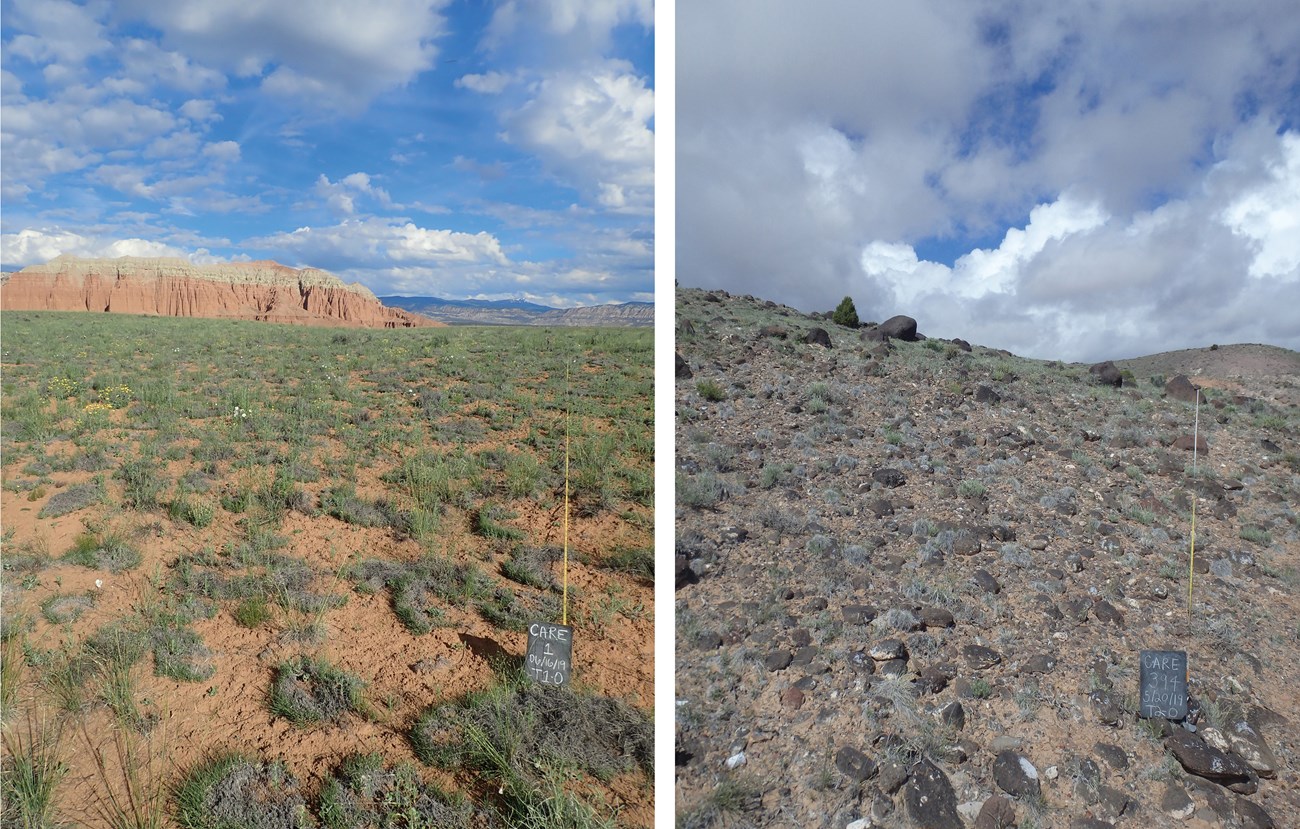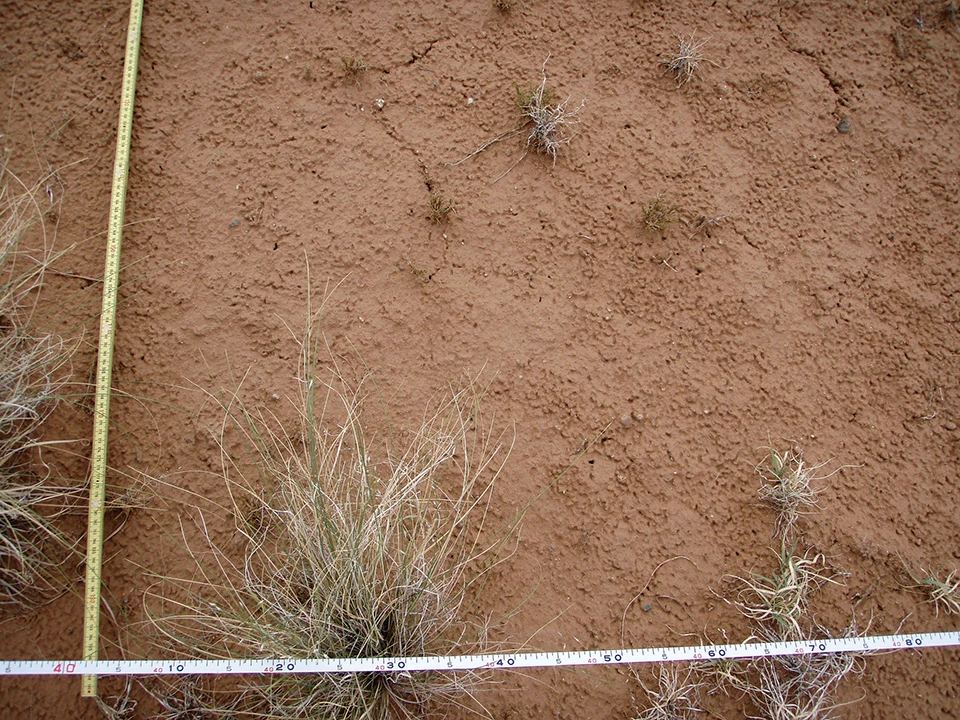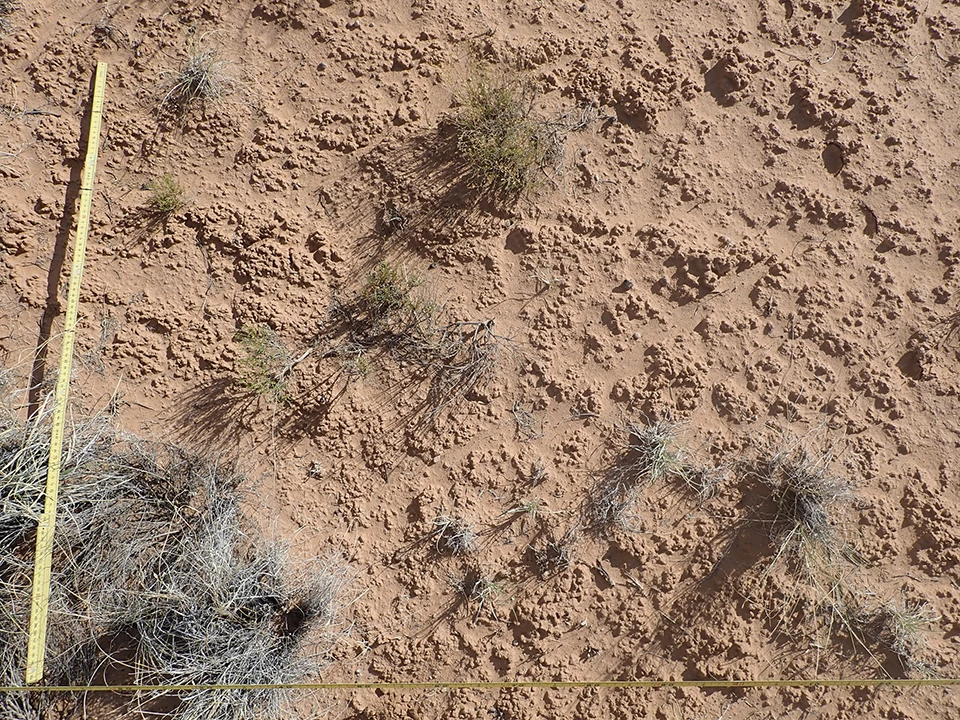Last updated: March 14, 2022
Article
Grassland Health on Grazed and Ungrazed Lands at Capitol Reef National Park, 2009–2018

At Capitol Reef National Park, long-term monitoring reveals some signs of recovery on previously grazed grasslands.
What We Wanted to Know
When Capitol Reef National Park was established in 1971, there were 19 active livestock-grazing allotments in the park. By the 1990s, all but two of these grazing permits were retired. Another was retired in 2018. Knowing the condition of park grasslands, how they’ve changed since grazing ended, and which factors are affecting their condition can help park managers figure out where restoration projects are most needed—and most likely to succeed. This helps ensure tax dollars are wisely spent.
But park managers don’t have the capacity to collect the information themselves. To help them obtain it, the Northern Colorado Plateau Network (NCPN) has monitored the ecological health of vegetation and soils in grasslands in the northern part of the park for more than 10 years. We do that by returning to the same places to measure different qualities of vegetation and soils year after year. Comparing the results tells us if conditions are getting better or worse. This analysis can also help us compare grazed to ungrazed grasslands, and tell us how climate may be affecting conditions on the ground.
What We Did
From 2009 to 2018, the NCPN monitored two groups of ecological sites, deep grasslands and rocky grasslands, at three livestock-grazing allotments with different grazing histories in the northern part of the park (see table). Deep grasslands were monitored in all three allotments. Rocky grasslands were monitored only in the Hartnet allotment, due to their paucity in the others.
At each monitoring site, we measured 11 parameters of vegetation and soil condition: total plant cover, perennial-grass cover, cool-season grass cover, warm-season grass cover, shrub cover, shrub density, frequency of exotic species, biological soil crust cover, bare-soil cover, soil stability, and canopy-gap size. Generally speaking, these parameters measure how much of the monitoring site is covered by plants, and the ability of soil to resist erosion.
| Allotment | Grazing history | Grassland type |
|---|---|---|
| Cathedral | ~80% of animal unit months (AUMs) retired in 1989, the rest retired in 1999 | deep grasslands |
| Rock Springs | Retired in 1989 | deep grasslands |
| Hartnet | Grazed until May 2018, then retired | deep grasslands, rocky grasslands |

What We Learned
Overall, vegetation and soils in the ungrazed Cathedral/Rock Springs (CRS) allotments were in relatively good condition. Trends were stable or improving (see table below). Vegetation in the CRS deep grasslands was generally stable, with increases in warm-season grass cover. The allotments had low invasion by exotic annual plant species. They showed good recovery from past grazing, based on limited historical data. Condition was both good and improving for all soil parameters.
Things looked somewhat different in the grazed Hartnet deep and rocky grasslands, where condition was declining for 9 of 22 parameters. Condition was considered good only for parameters related to shrubs and soils. In Hartnet deep grasslands, cool-season grass cover was very low, which may be due to both livestock-grazing pressure and warming conditions that did not favor cool-season grasses. Frequency of exotics was somewhat high. Hartnet rocky grasslands had fairly low invasion by exotic-plant species, but grass and shrub cover were decreasing and particularly susceptible to declines during drought.
Condition was improving for all soil parameters across all grassland types and sites. However, current conditions in the Hartnet deep grasslands suggest there is still a moderate-to-high potential for erosion.
| Vital sign | Indicator | Cathedral/Rock Springs deep grasslands (retired) | Hartnet deep grasslands (grazed) | Hartnet rocky grasslands (grazed) |
|---|---|---|---|---|
| Upland plant communities | Total cover |  |
 |
 |
| Perennial-grass cover |  |
 |
 |
|
| Cool-season grass cover |  |
 |
 |
|
| Warm-season grass cover |  |
 |
 |
|
| Shrub cover |  |
 |
 |
|
| Shrub density |  |
 |
 |
|
| Frequency of exotic species |  |
 |
 |
|
| Soil stability | Biological soil crust cover |  |
 |
 |
| Bare-soil cover |  |
 |
 |
|
| Soil-stability rating |  |
 |
 |
|
| Canopy-gap size |  |
 |
 |
Green  indicates the indicator was in good condition. Yellow
indicates the indicator was in good condition. Yellow  indicates condition that warrants moderate concern. Red
indicates condition that warrants moderate concern. Red  indicates condition that warrants significant concern. An upward arrow means the condition is improving. A sideways arrow means the condition is unchanging. A downward arrow means the condition is deteriorating. Note that decreasing frequency of exotic species, bare-soil cover, and canopy-gap sizes are considered improving trends. A dashed line means confidence is low. A solid line means confidence is medium. No conditions were reported with high confidence due to the relatively short dataset (≤10 years), wide credible intervals, and limited historical data. Rationale for Condition/Trend: Because the purpose of this report was to inform management, condition colors were included based on the literature and the author’s professional judgment. Vegetation in the Cathedral/Rock Springs deep grasslands was generally stable, with increases in warm-season grass cover. The allotments had low invasion by exotic annual plant species and good recovery from past grazing based on limited historical data. In Hartnet deep grasslands, cool-season grass cover was very low, which may be due to both livestock-grazing pressure and warming conditions that did not favor cool-season grasses. Frequency of exotics was somewhat high, which has been shown to be related to livestock disturbance. Hartnet rocky grasslands had fairly low invasion by exotic-plant species, but grass and shrub cover were decreasing and particularly susceptible to declines during drought in this soil type. Soils in the Cathedral/Rock Springs deep grasslands were in moderately good condition and continued to improve, but recovery from trampling disturbances is a slow process. Many areas of the Hartnet deep grasslands had soils trampled by livestock and in relatively poor condition, but wetter-than-average years likely contributed to some improvement in soil conditions. Soils in rocky grasslands had somewhat lower stability and biological soil crust (BSC) cover, but the surface was well protected by high cover of rocks that limited bare soil, prevented erosion, and limited the surface area where BSCs could form.
indicates condition that warrants significant concern. An upward arrow means the condition is improving. A sideways arrow means the condition is unchanging. A downward arrow means the condition is deteriorating. Note that decreasing frequency of exotic species, bare-soil cover, and canopy-gap sizes are considered improving trends. A dashed line means confidence is low. A solid line means confidence is medium. No conditions were reported with high confidence due to the relatively short dataset (≤10 years), wide credible intervals, and limited historical data. Rationale for Condition/Trend: Because the purpose of this report was to inform management, condition colors were included based on the literature and the author’s professional judgment. Vegetation in the Cathedral/Rock Springs deep grasslands was generally stable, with increases in warm-season grass cover. The allotments had low invasion by exotic annual plant species and good recovery from past grazing based on limited historical data. In Hartnet deep grasslands, cool-season grass cover was very low, which may be due to both livestock-grazing pressure and warming conditions that did not favor cool-season grasses. Frequency of exotics was somewhat high, which has been shown to be related to livestock disturbance. Hartnet rocky grasslands had fairly low invasion by exotic-plant species, but grass and shrub cover were decreasing and particularly susceptible to declines during drought in this soil type. Soils in the Cathedral/Rock Springs deep grasslands were in moderately good condition and continued to improve, but recovery from trampling disturbances is a slow process. Many areas of the Hartnet deep grasslands had soils trampled by livestock and in relatively poor condition, but wetter-than-average years likely contributed to some improvement in soil conditions. Soils in rocky grasslands had somewhat lower stability and biological soil crust (BSC) cover, but the surface was well protected by high cover of rocks that limited bare soil, prevented erosion, and limited the surface area where BSCs could form.
Grassland Recovery in Retired Allotments
Our analysis found some evidence that grasslands retired from grazing in the Cathedral and Rock Springs allotments show recovery over the past 10–30 years. Although trends in most vegetation indicators were stable from 2009 to 2018, warm-season grass cover increased in the CRS allotments. We expected to see increases in cool-season grass cover—a sign of recovery from past livestock grazing—but conditions appeared to be unchanged over our 10 years of monitoring. Historical data and photos suggest much recovery may have occurred before NCPN monitoring began. In the retired CRS allotments, soil stability and biological soil crust cover were higher, and increasing at a faster rate, than in the grazed Hartnet allotments. A soil-stability rating increase of 2.1 in the CRS allotments from 2009 to 2018 was an impressive rate of recovery. Soil stability is positively correlated with biological soil crust cover, and our repeat photos showed substantial crust development over the 10 years of monitoring (see figure).
Visual evidence of soil recovery


Left image
Soil surface at a monitoring plot in the Cathedral allotment in 2009.
Right image
Soil surface at a monitoring plot in the Cathedral allotment in 2018. Pinnacling of biological soil crust increased substantially by 2018.
Effects of Livestock Grazing on Hartnet Grasslands
Overall, our analysis indicated declining trends in condition for four of the seven vegetation indicators in the grazed Hartnet deep grasslands, compared to only one declining trend in the retired CRS deep grasslands. In the Hartnet deep grasslands, cover of cool-season grasses (typically favored by livestock) was notably low. In addition to pressure from livestock grazing, declining vegetation trends may be related to increasing aridity, as the Southwest continues to warm. Care should be taken when interpreting our data because differences are small and credible intervals in our models are relatively wide. However, the direction and consistency of these trends across several indicators are clear. Soil conditions appear to be improving in the Hartnet deep grasslands—but more slowly than in the CRS deep grasslands.Cover of biological soil crust is still low in the Hartnet deep grasslands.
Climate Drivers and Grasslands
In desert grasslands, previous-year precipitation affects the availability of water and nutrients for grasses the following spring. For all grass-cover metrics in Capitol Reef National Park, the effect of the previous year’s monsoon precipitation was twice as strong as that of cool-season precipitation. Our models also provided evidence that cool-season precipitation increased biological soil crust cover and decreased bare-soil cover, and that both cool-season and monsoon precipitation increased soil stability.
But there is still much uncertainty about how seasonal precipitation may or may not change in the future. We do know that as temperatures increase, so does evapotranspiration, meaning more water would be required to maintain current conditions. Changes in the seasonality of precipitation could be some of the most important drivers of change in mixed cool- and warm-season semiarid grasslands.
Livestock grazing in the Hartnet allotment was retired on May 1, 2018. A year later, NCPN monitoring crews began documenting any changes in vegetation or soils associated with this change in management. They noted some early signs of recovery in spring 2019: many tiny bunches of Indian ricegrass in the Hartnet deep grasslands that appeared to be thriving after the wet winter of 2018–2019. It is unclear if any of these grass seedlings survived the dry conditions later that summer, but events like this provide hope that cool-season grass cover in the Hartnet deep grasslands will increase after conditions are favorable for establishment.
Continued monitoring will be crucial to providing park managers with the information they need for science-based decisionmaking and effective resource allocation.
Information in this brief was summarized from D. L. Witwicki. 2020. Status and trends in upland vegetation and soils at Capitol Reef National Park, 2009–2018.
